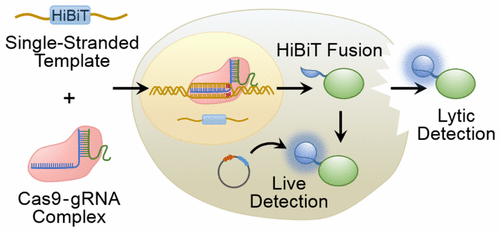当前位置:
X-MOL 学术
›
ACS Chem. Biol.
›
论文详情
Our official English website, www.x-mol.net, welcomes your feedback! (Note: you will need to create a separate account there.)
CRISPR-Mediated Tagging of Endogenous Proteins with a Luminescent Peptide
ACS Chemical Biology ( IF 4 ) Pub Date : 2017-09-21 00:00:00 , DOI: 10.1021/acschembio.7b00549 Marie K. Schwinn 1 , Thomas Machleidt 1 , Kris Zimmerman 1 , Christopher T. Eggers 1 , Andrew S. Dixon 2 , Robin Hurst 1 , Mary P. Hall 1 , Lance P. Encell 1 , Brock F. Binkowski 1 , Keith V. Wood 1
ACS Chemical Biology ( IF 4 ) Pub Date : 2017-09-21 00:00:00 , DOI: 10.1021/acschembio.7b00549 Marie K. Schwinn 1 , Thomas Machleidt 1 , Kris Zimmerman 1 , Christopher T. Eggers 1 , Andrew S. Dixon 2 , Robin Hurst 1 , Mary P. Hall 1 , Lance P. Encell 1 , Brock F. Binkowski 1 , Keith V. Wood 1
Affiliation

|
Intracellular signaling pathways are mediated by changes in protein abundance and post-translational modifications. A common approach for investigating signaling mechanisms and the effects induced by synthetic compounds is through overexpression of recombinant reporter genes. Genome editing with CRISPR/Cas9 offers a means to better preserve native biology by appending reporters directly onto the endogenous genes. An optimal reporter for this purpose would be small to negligibly influence intracellular processes, be readily linked to the endogenous genes with minimal experimental effort, and be sensitive enough to detect low expressing proteins. HiBiT is a 1.3 kDa peptide (11 amino acids) capable of producing bright and quantitative luminescence through high affinity complementation (KD = 700 pM) with an 18 kDa subunit derived from NanoLuc (LgBiT). Using CRISPR/Cas9, we demonstrate that HiBiT can be rapidly and efficiently integrated into the genome to serve as a reporter tag for endogenous proteins. Without requiring clonal isolation of the edited cells, we were able to quantify changes in abundance of the hypoxia inducible factor 1A (HIF1α) and several of its downstream transcriptional targets in response to various stimuli. In combination with fluorescent antibodies, we further used HiBiT to directly correlate HIF1α levels with the hydroxyproline modification that mediates its degradation. These results demonstrate the ability to efficiently tag endogenous proteins with a small luminescent peptide, allowing sensitive quantitation of the response dynamics in their regulated expression and covalent modifications.
中文翻译:

CRISPR介导的内源蛋白标记与发光肽
细胞内信号转导途径由蛋白质丰度的变化和翻译后修饰介导。研究信号传导机制和合成化合物诱导的作用的常用方法是通过过量表达重组报告基因。使用CRISPR / Cas9进行基因组编辑提供了一种通过将报告子直接附加在内源基因上来更好地保存本地生物学的方法。为此目的的最佳报道分子将很小,以至于对细胞内过程的影响可忽略不计,以最小的实验努力即可容易地与内源基因连接,并且足够灵敏以检测低表达的蛋白质。HiBiT是一种1.3 kDa的肽段(11个氨基酸),能够通过高亲和力互补(K D= 700 pM),具有源自NanoLuc(LgBiT)的18 kDa亚基。使用CRISPR / Cas9,我们证明了HiBiT可以快速有效地整合到基因组中,作为内源蛋白的报告子标签。无需克隆分离编辑后的细胞,我们就能量化低氧诱导因子1A(HIF1α)及其几个下游转录靶标对各种刺激的响应变化。与荧光抗体组合,我们进一步使用HiBiT将HIF1α水平与介导其降解的羟脯氨酸修饰直接相关。这些结果证明了用小的发光肽有效标记内源蛋白质的能力,从而允许敏感地定量其调节表达和共价修饰中的响应动力学。
更新日期:2017-09-21
中文翻译:

CRISPR介导的内源蛋白标记与发光肽
细胞内信号转导途径由蛋白质丰度的变化和翻译后修饰介导。研究信号传导机制和合成化合物诱导的作用的常用方法是通过过量表达重组报告基因。使用CRISPR / Cas9进行基因组编辑提供了一种通过将报告子直接附加在内源基因上来更好地保存本地生物学的方法。为此目的的最佳报道分子将很小,以至于对细胞内过程的影响可忽略不计,以最小的实验努力即可容易地与内源基因连接,并且足够灵敏以检测低表达的蛋白质。HiBiT是一种1.3 kDa的肽段(11个氨基酸),能够通过高亲和力互补(K D= 700 pM),具有源自NanoLuc(LgBiT)的18 kDa亚基。使用CRISPR / Cas9,我们证明了HiBiT可以快速有效地整合到基因组中,作为内源蛋白的报告子标签。无需克隆分离编辑后的细胞,我们就能量化低氧诱导因子1A(HIF1α)及其几个下游转录靶标对各种刺激的响应变化。与荧光抗体组合,我们进一步使用HiBiT将HIF1α水平与介导其降解的羟脯氨酸修饰直接相关。这些结果证明了用小的发光肽有效标记内源蛋白质的能力,从而允许敏感地定量其调节表达和共价修饰中的响应动力学。


























 京公网安备 11010802027423号
京公网安备 11010802027423号